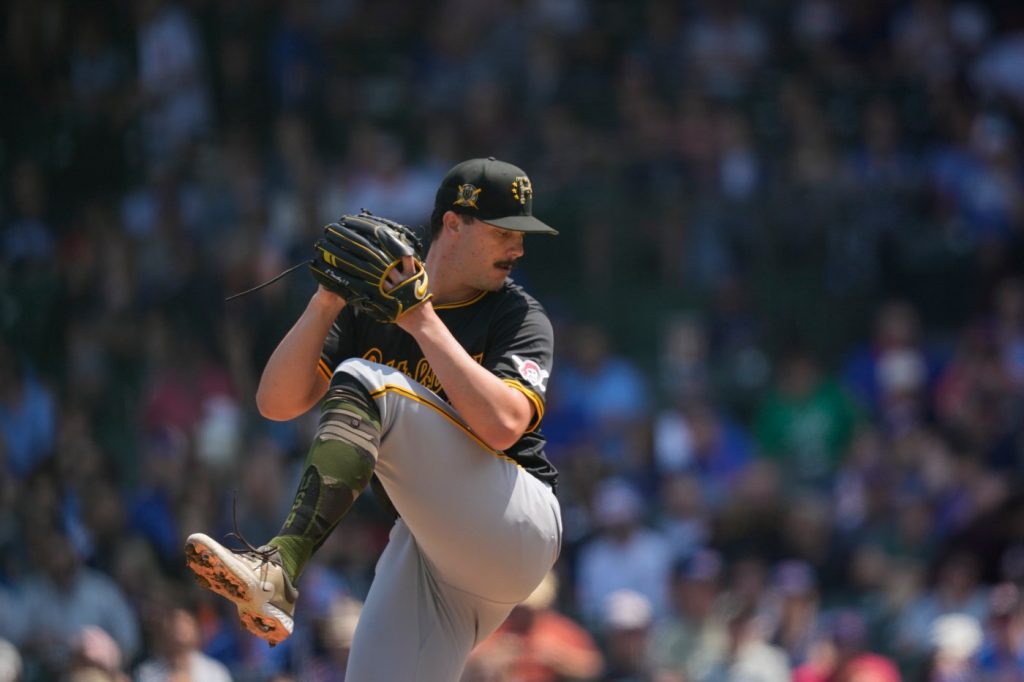PITTSBURGH — He dials it up into triple digits. He’s dating a social media star. He’s the talk of baseball.
He is the Giants’ next test, and despite being drafted just last July, might be their toughest yet.
He is Paul Skenes.
“There are some heralded prospects that gather a little bit more attention than others, so to speak. He’s definitely one of those guys,” manager Bob Melvin said. “And he’s off to a great start. I think overall it’s good for baseball and it’s a challenge for our team as well. And you always look forward to a challenge.”
Thursday’s series finale will be the third start of Skenes’ major-league career, and the first time he has faced an opponent besides the Cubs.
Since being drafted first overall out of LSU, the 21-year-old has been deemed the most polished pitcher to come from the amateur ranks since Stephen Strasburg and has at least lived up to those expectations, if not exceeded them. He made one start in rookie ball, two each in Single- and Double-A and seven this season at Triple-A — 12 minor-league starts — before he began dominating big-league hitters with an overpowering arsenal.
“You don’t face too many guys that sit 100,” outfielder Mike Yastrzemski said. “You face guys that touch 100. Or you’ll face a reliever that throws 100. But not too many starters are sitting there.”
The headliner of Skenes’ five-pitch mix is the four-seam fastball he throws 40% of the time, which clocks triple digits approximately one of out every six times the ball leaves his right hand. The pitch averages 99.7 mph, topping out at 101.9 and not registering one slower than 97.3.
As Yastrzemski noted, “Obviously the velocity is climbing in the league and most guys are throwing 94-96. But that’s still another bump up from that.”
Leaguewide, hitters are batting .233 against pitches between 95 and 99 mph, a small tick down from the overall league average of .240. When the pitcher cranks that up to 100-plus, the batting average plummets to .163.
Of the 184 four-seamers Skenes has thrown, not one has been put in play for hit. In fact, of the 100 pitches he threw in his last outing, the Cubs didn’t manufacture a hit off any of them. He was pulled after six no-hit innings, 11 strikeouts and one walk.
“Just get on time and start (your swing) on time,” said LaMonte Wade Jr., the Giants’ best fastball hitter this season. “It’s nothing crazy. I think everybody’s throwing that hard now.”
Overall, the Giants rank smack dab in the middle of the league when it comes to performance against fastballs — 14th in run value created against the pitch, according to Sports Info Solutions — but have also seen the third-slowest heaters of any team, on average, at 93.3 mph.
What separates Skenes — and why the baseball world is going crazy over him — is his combination of high-octane velocity and the ability to maintain it deep into his starts. His final pitch at Wrigley Field was a 100 mph heater that he powered past Mike Tauchman, painting the black of the inside corner.
While fans may be accustomed to seeing triple-digits on the radar gun from relievers such as Camilo Doval, Erik Miller and Randy Rodriguez, dialing it up for multiple innings is an entirely different beast than giving full exertion for three outs.
Few would understand better than Jordan Hicks, who set velocity records as a reliever but has paced himself since joining the starting rotation this season. His fastball averaged 100.3 mph in short bursts out of the bullpen, compared to 96 mph in 10 starts this season.
“I think I always did it in a way where I felt like I had to, like almost a defensive mechanism,” Hicks said. “Game’s on the line, eighth inning, ninth inning, whatever it is, like I want to give it every single ounce I have. … There’s a little difference in that aspect, but as a starter doing it, I think that’s pretty cool.”
Besides Skenes, who hits triple digits on 15.8% of his pitches, the starters clocking 100 mph or above most frequently are the Angels’ José Soriano, on 5.9% of his pitches, and the Reds’ Hunter Greene, on 2.8% of his pitches.
Pittsburgh Pirates pitcher Paul Skenes (30) talks to teammates in the dug out during a game against the Chicago Cubs on Friday, May 17, 2024, at Wrigley Field in Chicago. (Vincent Alban/Chicago Tribune)
Related Articles
SF Giants’ win streak comes to an end as they blow 4-run lead in 9th inning to Pirates
SF Giants activate Patrick Bailey from concussion protocol as they begin to get healthier
SF Giants’ Luis Matos named National League Player of the Week
Jordan Hicks dominates despite velocity drop, SF Giants complete sweep of Rockies
Luis Matos enters exclusive company as SF Giants finally win 3 in a row
Jared Jones, the Pirates’ other flamethrowing rookie who opposes the Giants on Wednesday, averages 97.3 mph and has hit 100 a dozen times, or 1.6% of his pitches, fourth among starting pitchers.
“You feel like you have the edge on most guys,” Hicks said of the advantage of elite velocity. “I think when you have a really good fastball, no matter if it’s just velocity or action with it, it just makes your offspeed better, and both those guys have really good offspeed to pair with their fastballs.”
In addition to the traditional secondary offerings of a changeup, curveball and slider, Skenes boasts a new pitch that he calls a “splinker,” a crossbred that has the velocity of a sinker and the movement of a split-finger. He takes about 5 mph off his four-seamer and replaces it with an additional 15 inches of vertical drop, on average.
“It’s like my splitter, but mine’s way slower,” Hicks said. “It’s fun to throw hard. It really is. It’s fun to just dominate people. That’s a different kind of domination than just getting ground balls and pop ups. Just pure striking guys out. It’s more fun. I just hope everybody stays healthy.”


